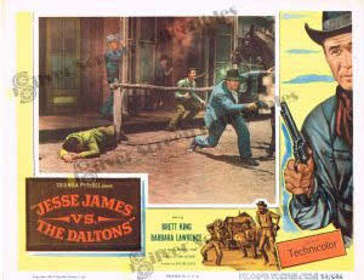Masterson of Kansas (1954) – 6.0

I have been watching a bunch of Wyatt Earp films of late but thought I would try one with his good friend Bat, Bat Masterson. And what do you know, Wyatt and Doc Holiday are in it. I can't get away from those two. At 69 minutes it is clearly meant as a B film but one with quality production with deep hued colors and some rugged landscapes. It is directed by William Castle before he went off on his own to direct horrors with gimmicks. In fact, he was directing a bunch of Westerns at the time - all B films I think - Jesse James vs the Daltons, The Law vs Billy the Kid, The Gun That Won the West - as well as adventures - Charge of the Lancers, Slaves of Babylon, Serpent of the Nile. It might be interesting to track all his films down and watch them. Not me. But somebody.
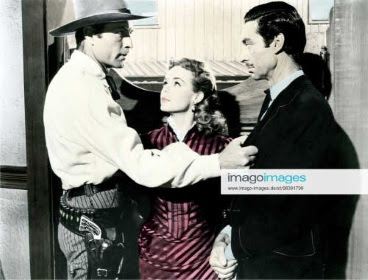
It takes place when Bat, Bat Masterson was the law in Dodge City. He hears that Doc Holiday is in town and wherever Doc goes, death is soon to follow. Masterson is played by the always solid like a cement block George Montgomery and Doc by James Griffith. Doc is considered to be the fastest draw in the West but Masterson wants him out of town. They are about to prove who is the fastest when Wyatt (Bruce Cowling) shows up and stops the entertainment. He needs Masterson to stop an Indian War. A man who has negotiated a peace treaty is up on charges of murder with a stacked deck against him.
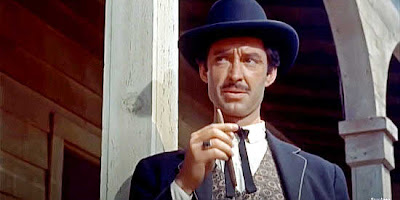
Masterson visits the Chief (yay - Jay Silverheels) and gets a warning; if the man hangs for a murder, it is war. It is up to him and Wyatt to prove the man's innocence and when his daughter (Nancy Gates) shows up it is an added incentive. I like the way Griffith plays Doc - snake eyes ready to kill but he wants to be sure that he gets to kill Masterson and no one else. A good O.K. Corral styled shoot-out at the end. And a mob calling for a lynching that can't wait 30-minutes for it and try to break into jail. Their form of social media back then. Let's lynch this guy. And the crowd joins in.
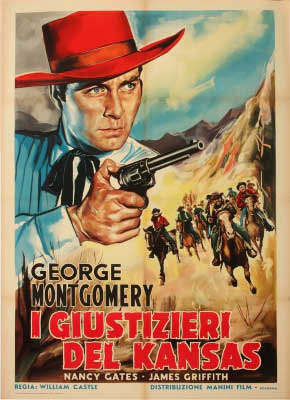
The Law vs Billy the Kid (1954) – 5.0
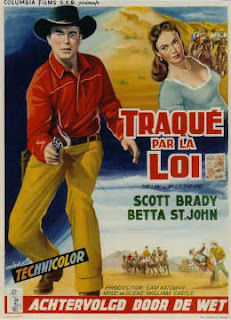
Billy the Kid was 21 when he was shot dead by Pat Garrett in 1881. Little did they know that Bob Dylan would be singing about them 90 years later.
"Playing around with some sweet signorita
Into her dark chamber she will greet you
In the shadows of the maizes she will lead you
Billy, and you're going all alone.
They say that Pat Garrett's got your number"
William Castle's version of Billy the Kid and Par Garrett is ever so slightly different from the truth. First of all, he is no kid as played by Scott Brady who was thirty at the time. And looks older. It takes away from the myth of the outlaw. By the time he died Billy was reputed to have killed over 20-people; a few here and a few there and it adds up. There have been a lot of movies about him and they tend to romanticize him just as we do with most outlaws. He was by most telling basically a psychopath with a quick draw. Castle turns him into an avenger who was only carrying out justice outside of the legal system which was corrupt. And Garrett was a righteous man who only reluctantly went after Billy. In fact, he did it for the reward. $500.
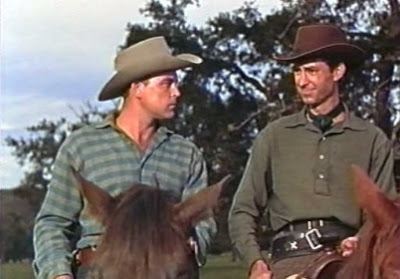
It begins with Billy working on a ranch and when the owner shortchanges his salary of $12, he takes what is owed and leaves. The owner and a man come after him and the owner goes back alone. Another man on the ranch is fired and meets up with Billy. He is Pat Garrett (James Griffith). The two of them soon sign up with another ranch and at dinner Billy stares at the niece (Betta St. John) of the owner like a sizzling steak. But it is all good. They fall in love. But when the owner who has treated Billy like a son is murdered in cold blood by the sheriff and his men, Billy goes rogue and tracks them down and kills them. Pat is persuaded by the Governor to take the job of sheriff and bring in Billy to save him. We know how that worked out. One of the bad guys with a large role is the Skipper, Alan Hale Jr.

Battle of Rogue River (1954) – 5.5
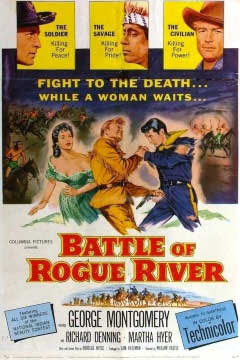
Director William Castle made a series of Westerns in the 1950s that were produced by Sam Katzman and distributed by Columbia. They all run a little over an hour and are in gleaming color. They have a few solid actors sprinkled within - in this case George Montgomery, Richard Denning and Martha Hyer. Not A actors but top B actors. Hyer is slowly becoming a favorite of mine. She can be the girl next door or sizzle the soles of your shoes. Like most males of my generation, I grew up watching Westerns - in movies but mainly on television. In the early 1960's TV was practically nothing but Westerns and I watched them all and still have fond feelings for them - Maverick, Have Gun Will Travel, The Rifleman, Bonanza, Gunsmoke. I'll still watch the occasional episode and they stand up fairly well - many shows deal with moral ambiguity and complex issues in which there is a lot of gray territory to traverse.
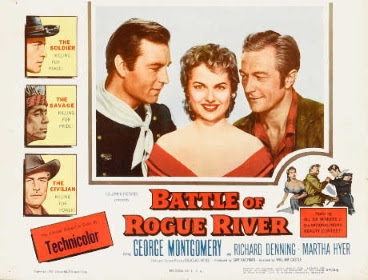
The one thing few of them dealt with was Native Americans. In any way. It was generally a white world. Western movies were different. Native Americans were often central to the plots - often on the warpath and heading stupidly right into a fuselage of rapid-fire guns. In truth, they were experts at guerilla warfare but always outgunned. The colonists always felt they had a right to the land. I can't watch those kinds of Westerns anymore and shy away from the genre because of it unless it is basically whites killing whites. A woke part of me, I guess. But there was also a sub-genre of films that treated the Native Americans with respect in which the white men were the troublemakers. This is one of those.
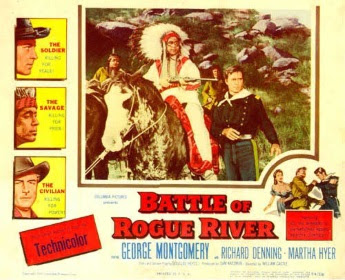
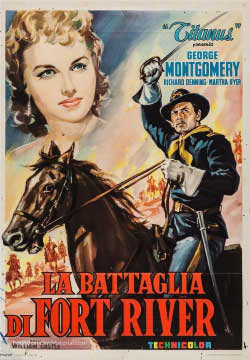
Jesse James vs the Daltons (1954) – 5.5
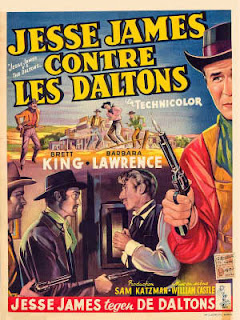
Well, the title should be The Son of Jesse James vs the Daltons since Jesse James never makes an appearance in this William Castle western. Castle directed eight films in 1954; four of them westerns which I have all watched over the past couple of days. I expect I will be given some sort of trophy. This has a different type of plot than most Westerns you will come across. And it's all plot until the very end. A fairly unknown cast unless you are a family member, but the acting is fine. I am a bit surprised that I don't recall the leads from anything else as they have been in a lot of films or TV shows.
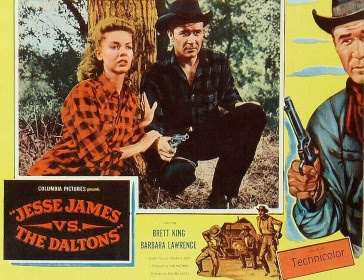
It begins in Coffeyville which may ring a few bells for those who study the Western outlaws. A woman is about to be lynched for murder. She is quite the slender reed with Ida Lupino eyes. She is Kate Manning (Barbara Lawrence) and is about to hang when a stranger rides his horse up the gallows and takes her away. When the posse follows, the preacher lines up his parishioners across the road so they can't pass and they all go home to dinner. Not much of a posse. The stranger is Joe Branch (Brett King) and he has rescued her because he thinks she can lead him to Jesse James. Who was supposedly killed ten years ago by Bob Ford (Rory Mallinson, who you wish had a bigger role).
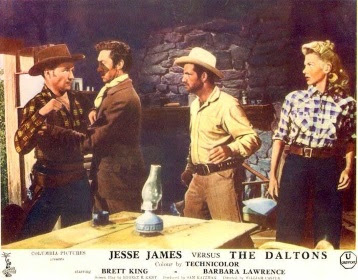
But he stashed $100,000 first. Branch thinks he may be Jesse's son and he wants to find out. He also needs the Daltons to help find Jesse, who may have faked his death. He sets up a nifty plan to get their attention - rob a train before they do and let them know where he is. James Griffith who shows up in three of these Westerns - his Doc Holliday was terrific in Masterson of Kansas - is Bob Dalton. In the end the Daltons ride to rob the banks at Coffeyville and fate and myth awaits them. The opening shot of the film is a gun pointed at the camera that fires. Kind of cool but the film was shot in 3-D and apparently, the audience all jumped back like a mad dog had attacked them.

I think I rated all four of these a five or six. They are low budget B films coming in at an hour but for that Castle does a nice job - they all hold together well and look great in color.
